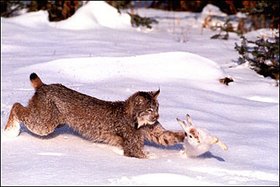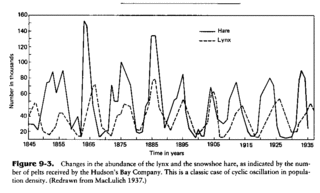Predator prey system
The predator prey problem refers to an ecological system in which we have two species, one of which feeds on the other. This type of system has been studied for decades and is known to exhibit very interesting dynamics. The right figure below shows a historical record taken over 50 years in the population of lynxes versus hares.

|

|
As can been seen from the graph, the annual records of the populations of each species are oscillatory in nature.
Contents
Modeling
Discrete time model
A simple model for this situation can be constructed using a discrete time
model by keeping track of the rate of births and deaths of each species.
Letting  represent the population of hares and
represent the population of hares and  represent the
population of lynxes, we can describe the state in terms of the
populations at discrete periods of time. Letting $k$ be the discrete
time index (e.g., the day number), we can write
represent the
population of lynxes, we can describe the state in terms of the
populations at discrete periods of time. Letting $k$ be the discrete
time index (e.g., the day number), we can write

where  is the hare birth rate per unit period and as a function
of the food supply
is the hare birth rate per unit period and as a function
of the food supply  ,
,  is the lynx death rate, and
is the lynx death rate, and  is the
interaction term. The interaction term models both the rate at which
lynxes eat hares and the rate at which lynxes are produced by eating
hares. This model makes many simplifying assumptions -- such as the
fact that hares never die of old age or causes other than being
eaten -- but it often is sufficient to answer basic questions about the
system.
is the
interaction term. The interaction term models both the rate at which
lynxes eat hares and the rate at which lynxes are produced by eating
hares. This model makes many simplifying assumptions -- such as the
fact that hares never die of old age or causes other than being
eaten -- but it often is sufficient to answer basic questions about the
system.
Continuous time model
Additional Information
Frequently Asked Questions
Exercises